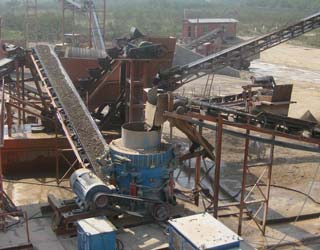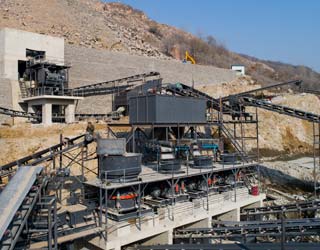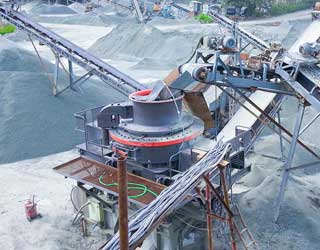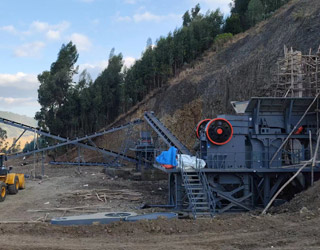
An Investigation into the Use of Manufactured Sand as a
For the manufactured sands, the sands with a -B notation were mixed to achieve the same S2 slump as the control and the required water/cement ratio was recorded. That w/c ratio was then kept constant for the remaining gradings of the same quarry sand, recording the change in slump observed in each concrete mix.
 WhatsAppGet PriceGet A Quote
WhatsAppGet PriceGet A Quote
Manufactured sand – a solution to the global sand shortage
First, manufactured sand is more uniform in structure compared with natural sand. It also has an advantage when it comes to concrete production, because manufactured sand is less needed in the concrete mix by a margin of 5 to 20% compared with natural sand to fill the voids volume between the particles. Even though the mechanical manufacturing
 WhatsAppGet PriceGet A Quote
WhatsAppGet PriceGet A Quote
How to make manufactured sand from crushing rocks
No.1 leading crushing and screening equipment manufacturer in Korea.
 WhatsAppGet PriceGet A Quote
WhatsAppGet PriceGet A Quote
An Investigation into the Use of Manufactured Sand as a
For the manufactured sands, the sands with a -B notation were mixed to achieve the same S2 slump as the control and the required water/cement ratio was recorded. That w/c ratio was then kept constant for the remaining gradings of the same quarry sand, recording the change in slump observed in each concrete mix.
 WhatsAppGet PriceGet A Quote
WhatsAppGet PriceGet A Quote
How Much Does A Ton of Sand Cost? (2022)
Washed sand – $28 per ton. Poteet red sand – $28 per ton. Concrete sand – $19.50 to $22.50 per ton. Road sand – $18.50 per ton. Cowbay or beach sand – $46 per ton. Decomposed granite – $39 per ton. Some retail stores offer sands in small quantities that may be used for minor repairs, gardening, etc.
 WhatsAppGet PriceGet A Quote
WhatsAppGet PriceGet A Quote
M sand or Manufactured sand: Meaning, Price & Use in
M sand meaning. M sand is a form of artificial sand, manufactured by crushing large hard stones, mainly rocks or granite, into fine particles, which is then washed and finely graded. It is widely used as a substitute for river sand for construction purposes, mostly in the production of concrete and mortar mix.
 WhatsAppGet PriceGet A Quote
WhatsAppGet PriceGet A Quote
What is m-sand (Manufactured sand)? Manufacture Process
Manufactured sand plants ensure proper grading for better particle size distribution. By washing the percentage of micro fines is controlled below 15 percent by weight. The washing facility also keeps the manufactured sand in wet or partially wet conditions. This helps in reducing the water absorption rate for better workability.
 WhatsAppGet PriceGet A Quote
WhatsAppGet PriceGet A Quote
Manufactured Sand vs. Natural Sand
Manufactured sand or manufactured fine aggregate (MFA) is produced by reducing larger pieces of aggregate into sand-sized aggregate particles. Manufactured sands tend to be used in mixtures in areas where natural sand is not available or not cost effective to be hauled to the needed location.
 WhatsAppGet PriceGet A Quote
WhatsAppGet PriceGet A Quote
Guideline Quarry assessment of manufactured sand crushed
Manufactured sand is a purpose-made, fine crushed aggregate produced under controlled conditions from a suitable sound source rock. It is designed for use in concrete, asphalt and other specific products. General crusher fines (dust) and sand resulting from lightly crushing (disaggregating) decomposed
 WhatsAppGet PriceGet A Quote
WhatsAppGet PriceGet A Quote
River Sand vs Manufactured Sand
River Sand vs Manufactured Sand. The natural river sand was the cheapest resources of sand. However the excessive mining of rive bed to meet the increasing demand for sand in construction industry has lead to the ecological imbalance in the state. Now the sand available in the riverbed is very coarse and contains very high percentage of silt
 WhatsAppGet PriceGet A Quote
WhatsAppGet PriceGet A Quote
Pit Sand | River Sand | M-Sand (Manufactured Sand) & other
M Sand (manufactured sand) produced by crushing of hard granite stone. MSand is manufactured through the process of shaping cubically, grading and cleaning by using VSI machine. The size of Manufactured sand is less than 4.75mm. the color of M sand is greyish-blue to red colour based on type of rock used in crushing.
 WhatsAppGet PriceGet A Quote
WhatsAppGet PriceGet A Quote
M-sand (Manufactured Sand)
M-Sand is manufactured sand M-sand is crushed aggregates produced from hard granite stone which is cubically shaped with grounded edges, washed and graded with consistency to be used as a substitute of river sand. Globally, natural sand and gravel extraction is becoming less of an option.
 WhatsAppGet PriceGet A Quote
WhatsAppGet PriceGet A Quote
Manufactured Sand Market Analysis, Share by 2025
Manufactured Sand Market
River Sand vs Manufactured Sand. The natural river sand was the cheapest resources of sand. However the excessive mining of rive bed to meet the increasing demand for sand in construction industry has lead to the ecological imbalance in the state. Now the sand available in the riverbed is very coarse and contains very high percentage of silt
 WhatsAppGet PriceGet A Quote
WhatsAppGet PriceGet A Quote
What is Manufactured Sand and Manufactured Sand vs Natural
Manufactured sand(M-Sand) is also called machine-made sand, which is made by mechanical crushing and screening. Rocks, mine tailings or industrial waste slag particles with a particle size of less than 4.75 mm. Manufactured sand properties. l. Artificial sand particles have edges and corners and irregular shapes, so they contain needle-like
 WhatsAppGet PriceGet A Quote
WhatsAppGet PriceGet A Quote
Different Types of Sand and What They Should be Used for
Jointing sand used for paving and patio joints, childrens sand pits and golf bunkers. Artificial Sand – Crushed Stone Sand, M Sand. If you have already read through the above type of sand you should now have guessed that artificial sand (or M sand – manufactured sand) is named as such as it’s artificially created and not naturally sourced.
 WhatsAppGet PriceGet A Quote
WhatsAppGet PriceGet A Quote
Manufactured Sand | acematerials.in
Manufactured sand is produced from hard granite stone by crushing. The crushed sand is of cubical shape with grounded edges, washed and graded to as a construction material. The size of manufactured sand (M-Sand) is less than 4.75mm. Due to fast growing construction industry and deficiency of river sand, the demand for M-sand has increased
 WhatsAppGet PriceGet A Quote
WhatsAppGet PriceGet A Quote
(PDF) Effect of manufactured sand on the durability
M 40 Grade concrete using complete manufactured sand yielded an excesses strength of 7.65%, 7.76% and 2.71% compared to conventional concrete for 7 days, 14 days and 28 days respectively,
 WhatsAppGet PriceGet A Quote
WhatsAppGet PriceGet A Quote
What Is M Sand | Properties of Manufactured Sand
Meanwhile manufactured sand can be crushed from hard granite rocks, it can be willingly accessible at the neighboring place, decreasing the cost of transportation from far-off river sand bed.. Consequently, the cost of construction can be measured by the use of manufactured sand as a substitute material for construction. The additional benefit of using M-Sand is, it can be dust-free, the sizes
 WhatsAppGet PriceGet A Quote
WhatsAppGet PriceGet A Quote
Artificial Sand
Artificial sand, also called crushed sand or mechanical sand (m sand), refers to rocks, mine tailings or industrial waste granules with a particle size of less than 4.75 mm. It is processed by mechanical crushing and sieving. In China, the artificial sand was mainly used in the construction of hydropower systems.
 WhatsAppGet PriceGet A Quote
WhatsAppGet PriceGet A Quote
(PDF) Effect of manufactured sand on the durability
M 40 Grade concrete using complete manufactured sand yielded an excesses strength of 7.65%, 7.76% and 2.71% compared to conventional concrete for 7 days, 14 days and 28 days respectively,
 WhatsAppGet PriceGet A Quote
WhatsAppGet PriceGet A Quote
Manufactured Sand
Manufactured Sand. Generally produced from quarry dust and altered during the production process to achieve a grading similar to naturally occurring sand. Application/Use. Often blended with naturally occurring sand for use in concrete manufacturing . Features & Benefits. Typically less than 5 millimetres.
 WhatsAppGet PriceGet A Quote
WhatsAppGet PriceGet A Quote
What are the Materials for Replacement of Sand in
Crushed sand (Manufactured sand) is produced by crushing rock (as in the case of coarse aggregate) to give particle size and grading at par with river sand, the texture may differ using Vertical Shaft Impactor Machines. The percentage passing 150 microns of manufactured sand is relaxed to 20% (while that of natural sand is limited to 10%).
 WhatsAppGet PriceGet A Quote
WhatsAppGet PriceGet A Quote
All About Sand Casting
The operator must firmly pack (or “ram”) the sand into each pattern to ensure there is no loose sand, and this can be done either by hand or by machine. After ramming, the patterns are removed and leave their exterior contours in the sand, where manufacturers can then create channels and connections (known as gates/runners) into the drag and a funnel in the cope (known as a “sprue”).
 WhatsAppGet PriceGet A Quote
WhatsAppGet PriceGet A Quote
The Pros and Cons of Manufactured Sand
The Disadvantages. Workability issues: Manufactured sand can be of a coarser and angular texture than natural sand, which is smooth and rounded due to natural gradation. This can lead to more water and cement requirement to achieve the expected workability, leading to increased costs. Larger proportion of micro fines: Manufactured sand can
 WhatsAppGet PriceGet A Quote
WhatsAppGet PriceGet A Quote
Manufactured sand washing plants CDE Asia
Manufactured Sand vs River Sand. Superior Strength: M-Sand has higher compressive and flexural strength.Due to weathering natural sand particles are rounded, whereas M Sand particles is angular and have a rougher surface texture, allowing better bonding with the mortar in concrete, thereby providing improved strength properties.
 WhatsAppGet PriceGet A Quote
WhatsAppGet PriceGet A Quote
Pit Sand | River Sand | M-Sand (Manufactured Sand) & other
M Sand (manufactured sand) produced by crushing of hard granite stone. MSand is manufactured through the process of shaping cubically, grading and cleaning by using VSI machine. The size of Manufactured sand is less than 4.75mm. the color of M sand is greyish-blue to red colour based on type of rock used in crushing.
 WhatsAppGet PriceGet A Quote
WhatsAppGet PriceGet A Quote
Manufactured Sand (M-Sand) in Construction | Advantages
Crushed sand can be of coarser and angular texture. This can lead to more water and cement requirement to achieve the expected workability. Manufactured sand can contain larger amounts of micro fine particles than natural sand, This can affect the strength and workability of the concrete. We are also using M-sand for current project.
 WhatsAppGet PriceGet A Quote
WhatsAppGet PriceGet A Quote
Manufactured Sand Market Analysis, Share by 2025
Manufactured Sand Market
M-sand is manufactured sand made from the crushing of rock for construction purposes in cement or concrete. M-sand is different from the natural river sand in its physical and mineral properties. The M-Sand is Manufactured sand is also called crushed sand. Crushed sand has a cubicle and angular shape.
 WhatsAppGet PriceGet A Quote
WhatsAppGet PriceGet A Quote
Sand
Sand is a granular material composed of finely divided rock and mineral particles. Sand has various compositions but is defined by its grain size. Sand grains are smaller than gravel and coarser than silt.Sand can also refer to a textural class of soil or soil type; i.e., a soil containing more than 85 percent sand-sized particles by mass.. The composition of sand varies, depending on the
 WhatsAppGet PriceGet A Quote
WhatsAppGet PriceGet A Quote
What is Fineness Modulus of Sand (Fine Aggregate) and
Calculation of Fineness Modulus of Sand. Let us say the dry weight of sample = 1000gm After sieve analysis the values appeared are tabulated below. Therefore, fineness modulus of aggregate = (cumulative % retained) / 100 = (275/100) = 2.75 Fineness modulus of fine aggregate is 2.75. It means the average value of aggregate is in between the 2 nd
 WhatsAppGet PriceGet A Quote
WhatsAppGet PriceGet A Quote



 Mecca 500TPH Granite Crushing Plant
Mecca 500TPH Granite Crushing Plant